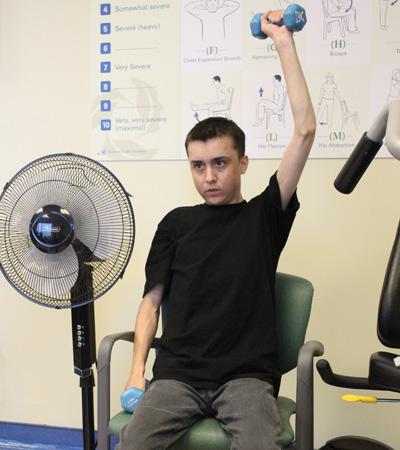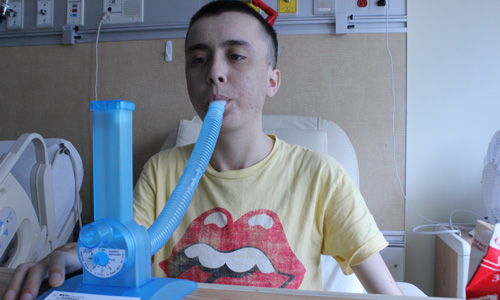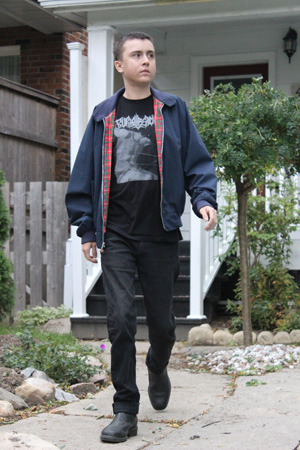
Triple transplant recipient Reid Wylie makes regular visits to Toronto General Hospital to go through a post-operative workout routine. (Photo: UHN)
A unique triple transplant has transformed the life of a 19-year-old Cystic Fibrosis patient who can now walk without an oxygen tank, exercise, eat full meals, and plan for the future.
Just two weeks after his life-saving three-organ transplant, Reid Wylie was walking around the transplant unit at Toronto General Hospital (TGH), inhaling and exhaling without coughing, and diligently keeping up his breathing exercises to expand his lungs.
"For the first time, when I walk, my legs are more tired than my lungs," says a smiling and shy Reid, who was diagnosed with Cystic Fibrosis at age two.
Being sick made Cystic Fibrosis patient Reid Wylie feel like there was no light in his future. His triple transplant has changed that. (Video: UHNToronto YouTube)
Related to this story:
Reid received a world-first transplant combining double lungs, liver, and a pancreas in the summer of 2015. The procedure took 17 hours, with 15 staff which included: surgeons, surgical fellows, anesthesiologists, operating room nurses and healthcare specialists in the use of the heart-lung machine during surgery.
A novel combination
Since 1990, the Multi–Organ Transplant Program at TGH has performed nine lung-liver transplants, but has never combined those with another organ – until Reid's triple transplant.
Cystic Fibrosis (CF), a chronic, genetic disease, affects many organs, including the lungs, the digestive system, liver and the pancreas. This results in improper digestion of food, as well as a breakdown of pancreatic tissue, leading to diabetes.
When medical management alone can no longer maintain the health of a person living with CF, transplantation, although not a cure, can improve a person's quality of life.
Since his diagnosis, Reid has had to take three to five enzyme pills with meals and snacks to digest his food, and insulin to control his diabetes. Draining about three cups of sticky mucus from his lungs, by clapping his chest and coughing, had to be done daily. His condition worsened this summer, and Reid was hospitalized with severe lung infection.
Respirologist Dr. Cecilia Chaparro, who treats CF patients at TGH and St. Michael's Hospital after they become transplant patients, has been treating Reid for about two-and- a-half years, with TGH transplant liver specialist Dr. Nazia Selzner.
Both agreed that a unique three-organ transplant offered Reid the best possibility of leading a more normal life.
"CF patients like Reid are a remarkable group of people, who live and enjoy their lives despite the limitations of their disease," says Dr. Chaparro. "They live fully because they don't know how long they have.
"The disease is unpredictable."
Dr. Cecilia Chaparro comments on the unique opportunities Toronto General Hospital's Multi-Organ Transplant Program can offer patients. (Video: UHNToronto)
"We all felt that Reid was ready for a transplant," adds Dr. Selzner, "He was very ill, able to walk only with oxygen, and both his lungs and liver were failing quickly.
"Despite that, he was motivated, courageous and never complained."
Dr. Shaf Keshavjee, Director of the Toronto Lung Transplant Program - the largest lung transplant program in the world - notes that the risk for performing lung transplants on CF patients has improved significantly since 1988, when the first one in the world was done at TGH.
"The question for our team was, 'Can we help CF patients even more by curing their diabetes and liver disease?'" says Dr. Keshavjee, who is also the University Health Network (UHN) Surgeon-in-Chief.
"Each transplant has risks, but to do all three at the same time takes dedicated, skilful teams in the Operating Room and in the care of the patient afterwards.
"It's a medical tour de force, a huge accomplishment."

Reid performs post-operative breathing exercises in his room prior to discharge from TGH. (Photo: UHN)
"Cystic Fibrosis Canada is proud to have supported innovations in transplantation processes at TGH," says Norma Beauchamp, President and CEO of Cystic Fibrosis Canada. "
"The world-class results have contributed to improving surgical rates for Canadians with CF, and are giving Reid a second chance at life."
A 'technically challenging' surgery
The double-lung transplant was performed first by a team led by Dr. Tom Waddell, Head of Thoracic Surgery at UHN, as this was the most urgent procedure. Lung transplants are always emergency surgeries, never elective. It took about 10 hours, longer than most.
Dr. Waddell describes it as "technically challenging" due to the inflammation of the lungs and the extra time it took to control the bleeding. He especially praises anesthesiologist Dr. Karen McCrae and the anesthesia team for their skill in keeping the patient stable by managing his blood pressure, breathing and circulation "minute by minute" while the surgeons worked.

Less than two months after his triple-transplant, Reid was back home and able to go for a walk around his neighbourhood, something impossible before the surgery.
(Photo: UHN)
Dr. Mark Cattral, Director of Pancreas Transplantation Program at UHN, led the team that transplanted the liver and pancreas as a whole unit. He received the nod from the anesthesia team to proceed after a careful assessment of Reid's vital signs – blood pressure, heart rate, oxygen levels - as stable enough to undergo another seven-hour transplant.
One of the crucial moments in that transplant was when the surgeons unclamped the blood vessels to the transplanted liver to restore blood flow throughout the body. That sudden rush can cause instability in the heart.
"This is the part that gives us grey hair," says Dr. Cattral. "That's when things can go wrong. Your eyes are on the monitors, watching the blood pressure, activity of the heart. In the first few moments, you sense how things are going to go. Patients can have a heart attack at this stage.
"In this case, Reid sailed right through it. The organs 'pinked up' nicely, very quickly. In a surgeon's world, that's what we are looking for. I was quite happy with how it all worked out. "
'The benefit exceeded the risk'
Although performing both the liver and pancreas transplant at the same time was a challenge, Dr. Cattral points out that the transplant program performs 45 pancreas or pancreas/kidney transplants a year, making it the second largest in North America. The liver transplant program performs about 150 transplants from deceased and living donors a year, making it one of the largest in North America.
"We were taking on added risks by combining the two transplants, but the benefit of doing both exceeded that risk," says Dr. Cattral, adding that the transplant has changed Reid's life completely.
"He really needed a break, and he got one with the help of a generous donor and our excellent lung, liver and pancreas teams."
Toni Emerson, Reid's mom, smiles every time she talks about the progress her son has made. His blood oxygen levels are now usually 99 per cent when he exercises – well within the normal range - and he has gained five kilograms, or 11 pounds, in seven weeks.
Toni Emerson, Reid's mother, reflects on the decision to go through with transplant despite the risks. (Video: UHNToronto YouTube)
"As a family we will always be grateful to that wonderful person and his or her family who made the decision to donate three organs to our son," she says. "They gave Reid his life back."
The Multi-Organ Transplant Program at TGH is the largest in Canada and within the top five in North America, performing more than 500 solid organ transplants a year – more than half of all transplants in Ontario - and providing lifelong follow-up care to almost 5,000 patients.
For more information about CF, please visit www.cysticfibrosis.ca
